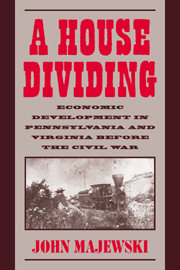Book contents
- Frontmatter
- Contents
- List of Tables
- List of Abbreviations
- Acknowledgments
- Maps
- Introduction: Regional Development in Comparative Perspective
- 1 Developmental Corporations in a Slave-Labor Society
- 2 Developmental Corporations in a Free-Labor Society
- 3 Railroads and Local Development
- 4 The Local Politics of Market Development
- 5 Urban Capital and the Superiority of Pennsylvania's Transportation Network
- 6 Why Antebellum Virginians Never Developed a Big City: Comparative Urban Development in Philadelphia and Eastern Virginia
- Epilogue: Railroad Networks and the Civil War
- Appendix on Sources and Methods
- Bibliography
- Index
3 - Railroads and Local Development
Published online by Cambridge University Press: 07 September 2010
- Frontmatter
- Contents
- List of Tables
- List of Abbreviations
- Acknowledgments
- Maps
- Introduction: Regional Development in Comparative Perspective
- 1 Developmental Corporations in a Slave-Labor Society
- 2 Developmental Corporations in a Free-Labor Society
- 3 Railroads and Local Development
- 4 The Local Politics of Market Development
- 5 Urban Capital and the Superiority of Pennsylvania's Transportation Network
- 6 Why Antebellum Virginians Never Developed a Big City: Comparative Urban Development in Philadelphia and Eastern Virginia
- Epilogue: Railroad Networks and the Civil War
- Appendix on Sources and Methods
- Bibliography
- Index
Summary
The Cumberland Valley Railroad immediately changed the commercial world of John Lefever. When the railroad was under construction in 1836, the Cumberland farmer recorded more than a dozen times that he “hewed,” “drew,” or “hauled” wood for the railroad, a task that he would periodically perform for many years. More importantly, the railroad made it more convenient and less expensive for Lefever to market his crops – instead of long wagon journeys to Baltimore and Philadelphia, Lefever now made short trips to the railroad depot. In January of 1840, for example, Lefever reported that he “[c]ame to Newville Depot. Sold my rye to Swoyer at 45 cts.” Over the next few weeks, he would continue hauling rye to Swoyer's mill until he had sold more than 250 bushels. It would be an exaggeration to say that the railroad revolutionized Lefever's life – Cumberland's farmers had been selling surpluses to Philadelphia markets for many decades – but now the railroad had brought national and international markets to the doorsteps of Cumberland's farmers.
Railroads had a similar impact on Albemarle residents such as T. L. Jones. A moderately prosperous yeoman farmer, Jones steadfastly recorded the details of farm life during the tumult of the Civil War. Even in the war-ravaged Virginia economy, frequent travel was an essential part of Jones's routine. Within a single year, Jones took dozens of trips to villages such as Warren and Scottsville, and traveled to larger towns such as Charlottesville, Richmond, and Lynchburg about once a month.
- Type
- Chapter
- Information
- A House DividingEconomic Development in Pennsylvania and Virginia Before the Civil War, pp. 59 - 84Publisher: Cambridge University PressPrint publication year: 2000



